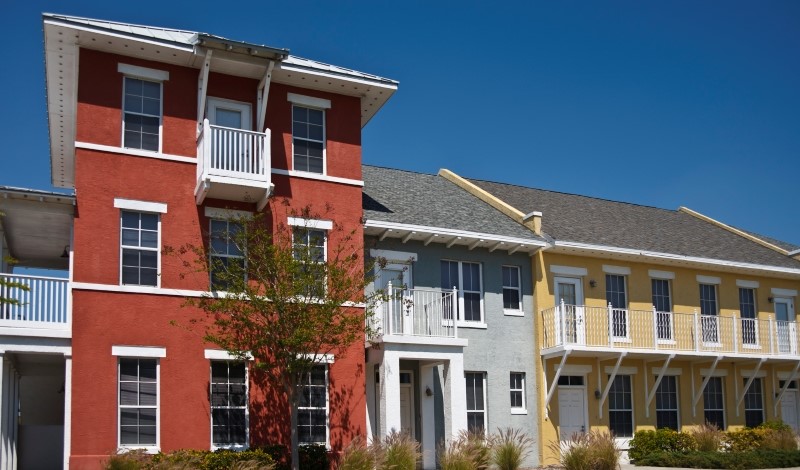
States should prohibit local zoning ordinances that bar affordable, climate-friendly housing.
In 2020, Nebraska enacted a law expected to reduce greenhouse gas (GHG) emissions from passenger vehicles and housing. But the law does not reference “climate change” or “global warming.” In fact, it does not mention GHG emissions at all.
Rather, the law aims to address Nebraska’s housing shortage by ordering municipalities to permit affordable housing units in areas previously reserved for single-family housing. In doing so, the law—intentionally or not—furthers climate goals as well. By increasing affordable housing, the law encourages the development of more energy-efficient and climate-friendly housing.
Other states should follow Nebraska’s lead by barring restrictive single-family zoning and mandating the development of more affordable housing units. Doing so not only would expand needed housing options, but also would help mitigate climate change because high-density housing is more energy-efficient than low-density, single-family housing.
Housing density refers to the number of housing units per unit of land. It is inversely related to a community’s GHG emissions because, on average, higher-density developments produce fewer emissions per housing unit. One study found that doubling an urban area’s density reduces carbon emissions from residents’ travel by 48 percent and from home energy use by 35 percent.
Single-family zoning, by contrast, accelerates urban sprawl. By increasing the distance between where people live and work, sprawl increases the amount people drive. Transportation constitutes the largest source of U.S. GHG emissions, with passenger cars alone producing over half of all transportation emissions. To make matters worse, sprawling developments are less amenable to low-carbon public transportation systems.
Single-family zoning also encourages the construction of larger houses and detached houses, both of which demand more energy than their smaller or attached counterparts. The greater the exposed surface area and the total indoor space in a house, the more energy its occupants use to cool or heat it.
Many states currently exert little influence over whether municipalities encourage or restrain the development of affordable housing. Such deference to local law is not new. Historically, U.S. municipal governments have wielded largely unchecked control over land use policy. Although municipal zoning originated in 1916 with the enactment of New York City’s first zoning resolution, local zoning laws first received the U.S. Supreme Court’s imprimatur in Village of Euclid v. Ambler Realty Company.
Over the last few decades, zoning has become more restrictive. Today, three-fourths of U.S. cities are zoned for single-family housing.
Although zoning is constitutional, municipalities are able to adopt ordinances only because state enabling legislation authorizes them to do so. Accordingly, states can—and should—revoke such authorization when doing so is in the best interest of the state as a whole. In addition to Nebraska, California, Maine, Oregon, and Utah currently bar restrictive zoning under certain circumstances.
State preemption may be an appropriate means by which to address collective action problems that arise over land use policy. Cutting GHG emissions is the quintessential collective action problem; each municipality’s policies, by themselves, are unlikely to produce a meaningful reduction in statewide emissions. Consequently, a single municipality may be unwilling to bear the burden of adopting climate-friendly reforms when doing so only yields significant benefits once others do the same.
Such an outcome, however, is not inescapable. State preemption can eliminate the free-rider phenomenon and assure each municipality that other municipalities’ inaction will not negate its efforts.
Those who oppose state preemption contend that restricting municipal zoning authority subverts direct democracy and local autonomy while also stifling innovation. Given these concerns, some scholars recommend limiting preemption to issues that impose statewide harm. Zoning is just such an issue; with respect to housing availability, if one municipality lacks affordable housing, other municipalities that have adopted reforms may bear the burden of making up for that shortage. With respect to climate change mitigation, one municipality’s excessive emissions will undermine state and nationwide efforts to cut emissions.
Although climate change measures rarely receive bipartisan support, statewide housing mandates have proponents from both sides of the political spectrum. Notably, two of the country’s most progressive states—Oregon and California—enacted preemption statutes substantially similar to policies adopted by two solidly conservative states—Nebraska and Utah. As the Nebraska and Utah statutes demonstrate, barring restrictive zoning may prove to be a politically-palatable means of enacting climate policy in more conservative states.
Furthermore, decades after the U.S. Supreme Court decided Village of Euclid, the New Jersey Supreme Court endorsed an alternative conception of zoning, ruling that municipalities cannot exercise their zoning authority in a manner inimical to the statewide interest because zoning must “promote public health, safety, morals or the general welfare.”
Other states should take heed of this principle: if local policies fail to promote the general welfare—whether in terms of housing availability or climate change mitigation—the state should intervene.



